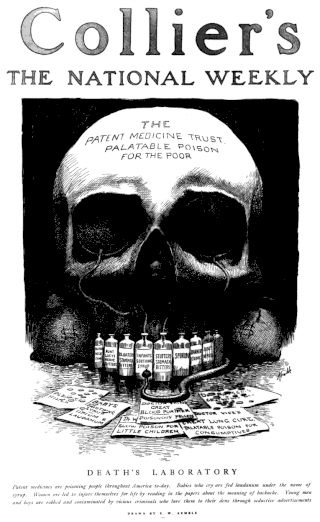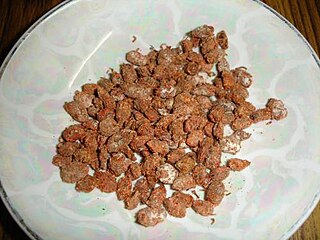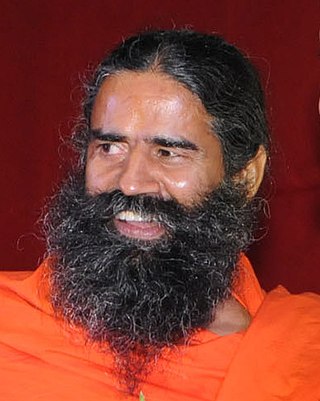
Quackery, often synonymous with health fraud, is the promotion of fraudulent or ignorant medical practices. A quack is a "fraudulent or ignorant pretender to medical skill" or "a person who pretends, professionally or publicly, to have skill, knowledge, qualification or credentials they do not possess; a charlatan or snake oil salesman". The term quack is a clipped form of the archaic term quacksalver, from Dutch: kwakzalver a "hawker of salve". In the Middle Ages the term quack meant "shouting". The quacksalvers sold their wares at markets by shouting to gain attention.

Ayurveda is an alternative medicine system with historical roots in the Indian subcontinent. It is heavily practiced in India and Nepal, where around 80% of the population report using ayurveda. The theory and practice of ayurveda is pseudoscientific.

A patent medicine is a non-prescription medicine or medicinal preparation that is typically protected and advertised by a trademark and trade name, and claimed to be effective against minor disorders and symptoms, as opposed to a prescription drug that could be obtained only through a pharmacist, usually with a doctor's prescription, and whose composition was openly disclosed. Many over-the-counter medicines were once ethical drugs obtainable only by prescription, and thus are not patent medicines.

Allopathic medicine, or allopathy, is an archaic and derogatory label originally used by 19th-century homeopaths to describe heroic medicine, the precursor of modern evidence-based medicine. There are regional variations in usage of the term. In the United States, the term is sometimes used to contrast with osteopathic medicine, especially in the field of medical education. In India, the term is used to distinguish conventional modern medicine from Siddha medicine, Ayurveda, homeopathy, Unani and other alternative and traditional medicine traditions, especially when comparing treatments and drugs.

Traditional medicine comprises medical aspects of traditional knowledge that developed over generations within the folk beliefs of various societies, including indigenous peoples, before the era of modern medicine. The World Health Organization (WHO) defines traditional medicine as "the sum total of the knowledge, skills, and practices based on the theories, beliefs, and experiences indigenous to different cultures, whether explicable or not, used in the maintenance of health as well as in the prevention, diagnosis, improvement and treatment of physical and mental illness". Traditional medicine is often contrasted with scientific medicine.

The history of alternative medicine covers the history of a group of diverse medical practices that were collectively promoted as "alternative medicine" beginning in the 1970s, to the collection of individual histories of members of that group, or to the history of western medical practices that were labeled "irregular practices" by the western medical establishment. It includes the histories of complementary medicine and of integrative medicine. "Alternative medicine" is a loosely defined and very diverse set of products, practices, and theories that are perceived by its users to have the healing effects of medicine, but do not originate from evidence gathered using the scientific method, are not part of biomedicine, or are contradicted by scientific evidence or established science. "Biomedicine" is that part of medical science that applies principles of anatomy, physics, chemistry, biology, physiology, and other natural sciences to clinical practice, using scientific methods to establish the effectiveness of that practice.
A panacea is any supposed remedy that is claimed to cure all diseases and prolong life indefinitely. Named after the Greek goddess of universal remedy Panacea, it was in the past sought by alchemists in connection with the elixir of life and the philosopher's stone, a mythical substance that would enable the transmutation of common metals into gold. Through the 18th and 19th centuries, many "patent medicines" were claimed to be panaceas, and they became very big business. The term "panacea" is used in a negative way to describe the overuse of any one solution to solve many different problems, especially in medicine. The word has acquired connotations of snake oil and quackery.

Unani or Yunani medicine is Perso-Arabic traditional medicine as practiced in Muslim culture in South Asia and modern day Central Asia. Unani medicine is pseudoscientific. The Indian Medical Association describes Unani practitioners who claim to practice medicine as quacks.

Dosha is a central term in ayurveda originating from Sanskrit, which can be translated as "that which can cause problems", and which refers to three categories or types of substances that are believed to be present conceptually in a person's body and mind. These Dosha are assigned specific qualities and functions. These qualities and functions are affected by external and internal stimuli received by the body. Beginning with twentieth-century ayurvedic literature, the "three-dosha theory" has described how the quantities and qualities of three fundamental types of substances called wind, bile, and phlegm fluctuate in the body according to the seasons, time of day, process of digestion, and several other factors and thereby determine changing conditions of growth, aging, health, and disease.

Ramdev, known also by the prefix Baba, is an Indian yoga guru, businessman and brand ambassador for Patanjali Ayurved. He is primarily known for being a proponent of yoga and ayurveda in India. Ramdev has been organizing and conducting large yoga camps since 2002 and broadcasting his yoga classes on various TV channels. He co-founded Patanjali Ayurved and Patanjali Yogpeeth with his colleague Balkrishna in 2006. Ramdev has received criticism over his comments related to modern medicine, yoga, and ayurveda.

Siddha medicine is a form of traditional medicine originating in southern India. It is one of the oldest systems of medicine in India.
The following outline is provided as an overview of and topical guide to medicine:

Homeopathy is fairly common in some countries while being uncommon in others. In some countries, there are no specific legal regulations concerning the use of homeopathy, while in others, licenses or degrees in conventional medicine from accredited universities are required.
The Ministry of Ayush, a ministry of the Government of India, is responsible for developing education, research and propagation of traditional medicine and alternative medicine systems in India. Ayush is a name devised from the names of the alternative healthcare systems covered by the ministry: ayurveda, yoga & naturopathy, Unani, Siddha, Sowa Rigpa, and homeopathy.

Patanjali Yogpeeth is a yoga institute located in Haridwar, Uttarakhand, India. Founded in 2006 and named after the Rishi Patanjali, the purpose of the institute is to practice, research, and develop yoga and ayurveda. The institute is the flagship project of the yoga teacher and entrepreneur Ramdev.
Warburg's tincture was a pharmaceutical drug, now obsolete. It was invented in 1834 by Dr. Carl Warburg.

The Drugs and Cosmetics Act, 1940 is an act of the Parliament of India which regulates the import, manufacture and distribution of drugs in India. The primary objective of the act is to ensure that the drugs and cosmetics sold in India are safe, effective and conform to state quality standards. The related Drugs and Cosmetics Rules, 1945 contains provisions for classification of drugs under given schedules and there are guidelines for the storage, sale, display and prescription of each schedule.
Online pharmacy laws in India are still in nascent stage and there are no dedicated online pharmacy laws in India. The Information Technology Act 2000 governs some of the legal issues pertaining to online dealings but it is silent on the aspect of online pharmacy. As a result, illegal online pharmacies have been increasing in India. It has been said that, if properly regulated, online pharmacies in India could prove beneficial to various stakeholders.
The Schedule J of the Drugs and Cosmetics Rules, 1945 of India contains "a list of diseases and ailments which a drug may not claim to prevent or cure". Under Rule 106 of the Drugs and Cosmetics Act, 1940, a drug cannot make claims to treat or prevent any of the diseases or reform the conditions listed.
The Drugs and Cosmetics Rules, 1945 are the rules which the government of India established through the Drugs and Cosmetics Act, 1940. These rules classify drugs under given schedules and present guidelines for the storage, sale, display and prescription of each schedule.













